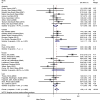Higher incidence of HCV in females compared to males who inject drugs: A systematic review and meta-analysis
- PMID: 27790803
- PMCID: PMC5239758
- DOI: 10.1111/jvh.12628
Higher incidence of HCV in females compared to males who inject drugs: A systematic review and meta-analysis
Abstract
Women who inject drugs have been shown to have higher incidence of HIV and risk behaviours than men, but there are conflicting reports about hepatitis C virus (HCV) incidence. We systematically reviewed the literature to examine the female-to-male (F:M) HCV incidence in female and male persons who inject drugs (PWID), and also to explore the heterogeneity (i.e. methodological diversity) in these differences. We searched PubMed and EMBASE for studies published between 1989 and March 2015 for research that reported incidence of HCV infection by sex or HCV incidence F:M rate ratio. A total of 28 studies, which enrolled 9325 PWID, were included. The overall pooled HCV incidence rate (per 100 person-years observation) was 20.36 (95% CI: 13.86, 29.90) and 15.20 (95% CI: 10.52, 21.97) in females and males, respectively. F:M ratio was 1.36:1 (95% CI: 1.13, 1.64) with substantial heterogeneity (I-squared=71.6%). The F:M ratio varied by geographic location from 4.0 (95% CI: 1.80, 8.89) in China to 1.17 (95% CI: 0.95, 1.43) in the U.S. In studies which recruited participants from community settings, the F:M ratio was 1.24 (95% CI: 1.03, 1.48), which was lower than that reported in the clinical settings (1.72, 95% CI: 0.86, 3.45). The number of studies included provided sufficient statistical power to detect sex differences in this analysis. Our findings raise questions and concerns regarding sex differences with respect to the risk of HCV. Both behavioural and biological studies are needed to investigate causes and potential mechanisms as well as sex-specific prevention approaches to HCV infection.
Keywords: females; hepatitis C; incidence; meta-analysis; sex differences; systematic review.
© 2016 John Wiley & Sons Ltd.
Conflict of interest statement
Authors have no commercial or other association that might pose a conflict of interest.
Figures




References
-
- Gower E, Estes C, Blach S, Razavi-Shearer K, Razavi H. Global epidemiology and genotype distribution of the hepatitis C virus infection. J Hepatol. 2014;61(1 Suppl):S45–57. - PubMed
-
- Mohd Hanafiah K, Groeger J, Flaxman AD, Wiersma ST. Global epidemiology of hepatitis C virus infection: new estimates of age-specific antibody to HCV seroprevalence. Hepatology. 2013;57(4):1333–42. - PubMed
-
- Wedemeyer H, Dore GJ, Ward JW. Estimates on HCV disease burden worldwide – filling the gaps. J Viral Hepat. 2015;22(Suppl 1):1–5. - PubMed
Publication types
MeSH terms
Grants and funding
LinkOut - more resources
Full Text Sources
Other Literature Sources
Medical

